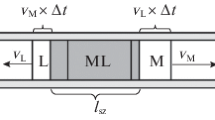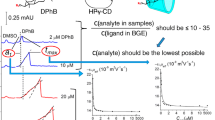Abstract
The binding of 4 s-triazines herbicides and metabolites, ameline, hydroxyatrazine, atraton, and ametryn to 12 structurally different humic substances was studied by affinity capillary electrophoresis. Binding data were confronted to the structural data of humic acids obtained from spectrometric measurements (UV-Vis, FT/IR, NMR), elemental analysis and potentiometric titration. The results obtained with principal component analysis and partial least square analysis clearly show the importance of carboxylic acidity and aromaticity of the humic ligands in relation to the partial positive charge and relative hydrophobicity of the pesticides.






Similar content being viewed by others
References
Antti H, Holmes N, Nicholson J (2002) Multivariate solutions to metabolic profiling and functional genomics
Doytchinova I, Blythe J, Flower D (2001) Additive method for the prediction of protein-peptide binding affinity. Application to the MHC class I molecule HLA-A*0201 Journal of proteome research
Eriksson L, Antti H, Gottfries J, Holmes E, Johansson E, Lindgren F, Long E, Lundstedt T, Trygg J, Wold S (2004) Using chemometrics for navigating in the large data sets of genomics, proteomics, and, metabonomics (gpm) 380: 419–429
Freitag D, Schmitt-Kopplin P, Simon R, Kaune A, Kettrup A (1999) Interactions of hydroxys-triazines with SDS-micelles by micellar electrokinetic capillary chromatography (MEKC).Electrophoresis 20:1568–1577
Kuhn R, Hoffstetter-Kuhn S (1993) Capillary electrophoresis: Principles and practice, Springer Laboratory—Springer Verlag, Berlin, Heidelberg, pp 191–204
Kulikova N, Perminova IV (2002), Binding of atrazine to humic substances from soil, peat, and coal related to their structure. Environ Sci Technol 36:3720–3724
Peuravuori J (2001) Binding of pyrene on lake aquatic humic matter: The role of structural descriptors. Analytica Chimica Acta 429:75–89
Sandberg M, Eriksson L, Jonsson J, Sjöström M, Wold S (1998) New chemical descriptors relevant for the design of biologically active peptides, A multivariate characterization of 87 amino acids. J Med Chem
Schmitt-Kopplin Ph, Trapp I, Garrison AW, Freitag D, Kettrup A (1997a) Binding of s-triazines to dissolved humic substances: Electrophoretic approaches using affinity capillary electrophoresis (ACE) and micellar electrokinetic chromatography (MEKC). Chemosphere 35:55–75
Schmitt-Kopplin Ph, Garrison AW, Freitag D, Kettrup A (1997b) Capillary isoelectric focusing (CIEF) for the characterization of humic substances. Water Res 31(8):2037–2049
Schmitt-Kopplin Ph, Hertkorn N, Schulten HR, Freitag D, Kettrup A (1998a) Structural Changes in a dissolved soil humic acid during photochemical degradation processes under O2 and N2 atmosphere. Environ Sci Technol 32(17):2531–2541
Schmitt-Kopplin Ph, Garmash AV, Kudryavtsev AV, Perminova I, Hertkorn N, Freitag D, Kettrup A (1999a) Mobility distribution description of synthetic and natural polyelectrolytes with capillary zone electrophoresis. J AOAC Int 82(6):1594–1603
Schmitt-Kopplin Ph, Hertkorn N, Garrison AW, Freitag D, Kettrup A (1998b) Influence of borate buffers on the electrophoretic behavior of humic substances in capillary zone electrophoresis. Anal Chem 70:3798–3808
Schmitt-Kopplin Ph, Burhenne J, Freitag D, Spiteller M, Kettrup A (1999b) Development of capillary electrophoresis methods for the analysis of fluoroquinolones and application to the study of the influence of humic substances on their photodegradation in aqueous phase. J Chromatogr A 837:253–265
Schmitt-Kopplin P, Junkers J (2003) Capillary electrophoresis of natural organic matter. J Chromatogr A 998:1–20
Steinberg CEW, Haitzer M, Brüggemann R, Perminova IV, Yashchenko NY, Petrosyan VS (2000) Towards a quantitative structure activity relationship (QSAR) of dissolved humic substances as detoxifying agents in freshwaters. Int Rev Hydrobiol 85:253–266
Terabe S, Otsuka K, Ando T (1985) Electrokinetic chromatography with micellar solution and open tubular capillary. Anal Chem 57:834–841
Acknowledgements
Heidi Neumeier from GSF is thanked for kind technical assistance in capillary electrophoresis and FTIR. Dr. N. Herkorn is thanked for the NMR measurements.
Author information
Authors and Affiliations
Corresponding author
Rights and permissions
About this article
Cite this article
Lucio, M., Schmitt-Kopplin, P. Modeling the binding of triazine herbicides to humic substances using capillary electrophoresis. Environ Chem Lett 4, 15–21 (2006). https://doi.org/10.1007/s10311-005-0017-y
Received:
Accepted:
Published:
Issue Date:
DOI: https://doi.org/10.1007/s10311-005-0017-y




